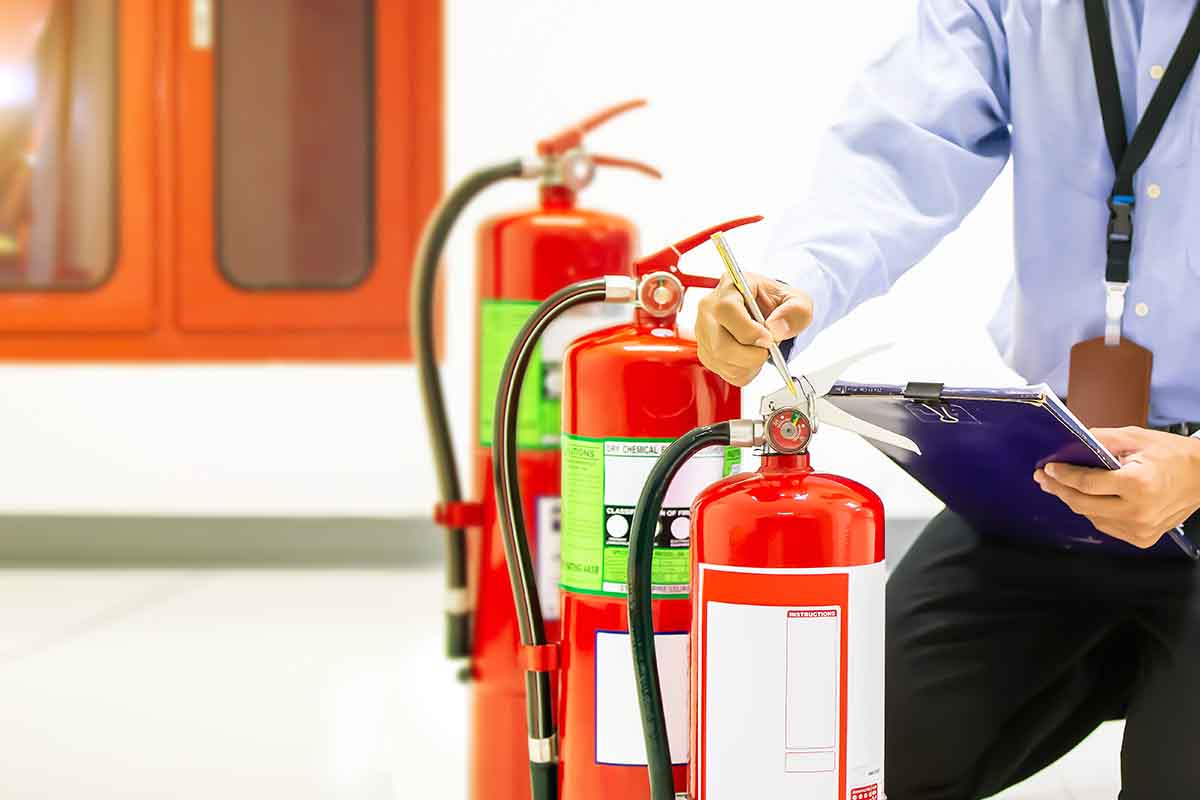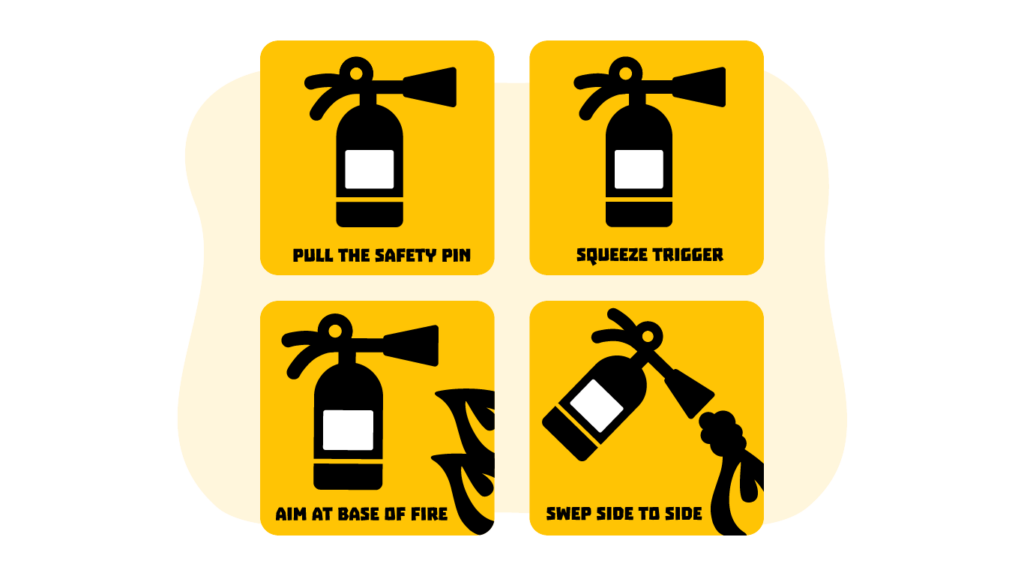Safety Talk On Fire Extinguisher Usage

Fire extinguishers are an important part of workplace safety. In order to use them safely and effectively, it is important to understand how they work and the proper way to use them. This article will provide an introduction to fire extinguisher use in the workplace. Correct fire extinguisher usage in the workplace could make a significant difference to the safety of of the workplace:
- Fires and explosions kill 200 and cause more than 5,000 injuries to workers each year in the US
- U.S. businesses lose more than $2.3 billion in property damage from fires every year
Don’t burn, learn!

Why is correct fire extinguisher usage important?
Fire extinguishers are an essential element of any workplace safety program. They can be used to control small fires before they become out of control, and can help keep you and your colleagues safe in the event of a larger fire.
However, it is important to use fire extinguishers correctly. If you do not know how to use them safely and effectively, you could put yourself and your colleagues at risk.
It is also important to make sure that all workers know how to use fire extinguishers properly. This way, if a fire does break out, everyone will be able to respond quickly and effectively.
Knowledge of correct usage also prevents making the fire worse by using the wrong extinguisher for the fire.
OSHA regulations for fire extinguisher usage
As fire extinguishers are such an important element of safety in the workplace, OSHA has a dedicated standard to deal with the correct usage and maintenance of them:
The administration also has standards that relate to fire protection and safety in more general terms:
Fire extinguisher usage hazards
Incorrect fire extinguisher usage can lead to serious injury or death. For example, if you try to fight a fire with the wrong type of extinguisher, you could make the fire worse. You could also injure yourself or others if you use an extinguisher incorrectly.
Not knowing where a fire extinguisher is located can cause a delay to fighting a fire, which could lead to injuries and damage. Being unable to correctly use the extinguisher is another hazard and not understanding the distance from which you can adequately quench a fire is another hazard of fire extinguisher usage.
Fire extinguisher usage Toolbox Talk
Being able to use a fire extinguisher correctly could save your life and those of your colleagues too.
When using a fire extinguisher, always keep the following in mind:
- Aim at the base of the fire.
- Squeeze the handles to discharge the extinguisher.
- Sweep the extinguisher from side to side, maintaining a constant distance from the fire.
- Keep your back to an exit
- The best way to fight a fire is to deprive it of oxygen. So, if possible, close doors and windows leading into the room where the fire is burning.
- When using a Class A extinguisher, always aim at the base of the fire.
Remember that not all fire extinguishers are used to extinguish all fires. You should make yourself aware of the fire hazards in your workplace, as well as the types of extinguishers you will need and where to find them.
| Fire Class | Characteristics | Type of Extinguisher Required |
| A | Solids (paper, wood, cardboard, building materials, and other solid combustible materials) | Water, dry chemical, clean agent |
| B | Liquids (cleaning fluid, fuel, paint, etc.) or gases (natural gas, LPG, etc.) | Carbon dioxide, dry chemical, clean agent |
| C | Electrical equipment | Carbon dioxide, dry chemical, clean agent. Not water under any circumstances. |
| D | Flammable metals | Dry powder and specialist suppression depending on the metal |
| K | Cooking fats and oils | Wet chemical |
Fire Extinguisher Inspection Tips
- Every 30 days, extinguishers need to be checked with a formal inspection once a year. These inspections should also be documented.
- When inspecting a fire extinguisher, make sure the pressure is correct. An arrow on a gauge should be located in the green area to show the correct pressure.
- Make sure that the pin is still in its place. Sometimes the pin can be bumped out, leading to accidental discharge.
- Check for rust and make sure the label is legible.

By not using a fire extinguisher correctly, you can leave yourself open to injuries caused by fire. These include burns, which can be very painful and can often lead to long-term damage, including scarring, skin grafts, and even amputation in some cases.
In addition to burns, fire can also cause smoke inhalation, which can lead to respiratory problems, and carbon monoxide poisoning, which can be deadly. It is therefore essential that you know how to use a fire extinguisher properly in order to protect yourself and your colleagues from these dangers.
Questions to employees
- What are the main fire hazards in this workplace?
- Which types of fire extinguishers do you need close at hand?
- What should you do if you cannot put out the fire with the extinguisher?
Promote fire extinguisher usage with this email template
Dear Colleagues,
As we all know, correct fire extinguisher usage is essential for the safety of ourselves and our colleagues. I would like to take this opportunity to remind you of the proper way to use a fire extinguisher.
When using fire extinguishers, remember the PASS technique:
1. Pull the pin. This will release the locking mechanism and allow you to operate the extinguisher.
2. Aim at the base of the fire. The extinguisher should be pointed at the source of the fire, not just at the flames.
3. Squeeze the lever. This will discharge the extinguishing agent.
4. Sweep from side to side. Move towards the fire while sweeping the extinguisher back and forth across the flames.
Remember to never stand directly in front of a fire when trying to extinguish it – you may become trapped by the flames!
I hope you find this information helpful. Please don’t hesitate to contact me if you have any questions or concerns.
Yours sincerely,
[Your name]
Video on fire extinguisher usage
Fire extinguisher usage meme
Conclusion
Fire extinguishers are an important part of any workplace safety plan, and it is essential that everyone understands how to use them correctly and safely. When used properly, fire extinguishers can help control a small fire until emergency responders arrive. However, if they are not used correctly, they can actually make the fire worse. Make sure you know the correct fire extinguisher procedures.


